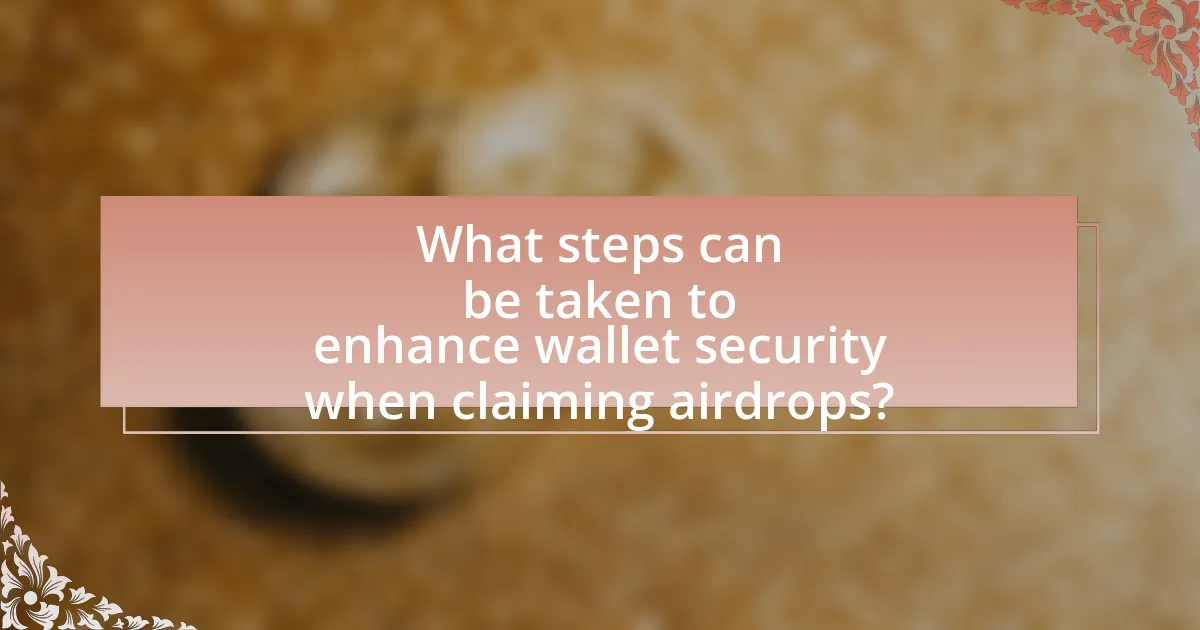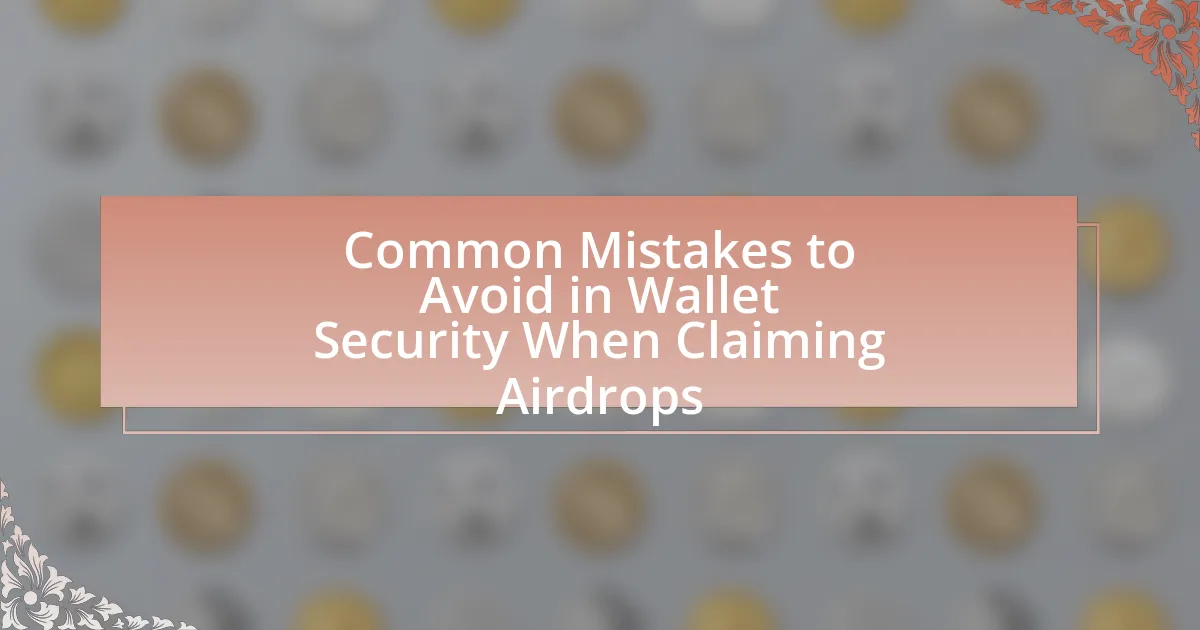The article focuses on common mistakes to avoid in wallet security when claiming airdrops, emphasizing the importance of safeguarding digital assets. Key issues include using insecure wallets, neglecting two-factor authentication, and sharing private keys, which can lead to significant financial losses. The article highlights the risks associated with poor wallet security, such as theft and identity fraud, and provides best practices for enhancing security, including the use of hardware wallets and verifying airdrop sources. Additionally, it discusses the impact of phishing attacks and insecure networks on wallet integrity, offering practical tips for users to maintain security before and after claiming airdrops.

What are Common Mistakes to Avoid in Wallet Security When Claiming Airdrops?
Common mistakes to avoid in wallet security when claiming airdrops include using insecure wallets, failing to enable two-factor authentication, and sharing private keys. Insecure wallets, such as those that are not hardware-based or lack encryption, expose users to hacking risks. Two-factor authentication adds an essential layer of security, and its absence can lead to unauthorized access. Sharing private keys compromises wallet security, as anyone with access can control the funds. According to a report by CipherTrace, over $1.9 billion was lost to cryptocurrency theft in 2020, highlighting the importance of robust wallet security practices.
Why is wallet security crucial when claiming airdrops?
Wallet security is crucial when claiming airdrops because it protects users from potential theft and fraud. Airdrops often require users to provide their wallet addresses, which can be exploited by malicious actors to gain unauthorized access to funds. According to a report by Chainalysis, over $1.4 billion was lost to cryptocurrency theft in 2021, highlighting the importance of securing wallets against such risks. Ensuring robust wallet security measures, such as using hardware wallets and enabling two-factor authentication, significantly reduces the likelihood of losing assets during the airdrop process.
What risks are associated with poor wallet security?
Poor wallet security exposes users to significant risks, including theft of funds, loss of access to assets, and identity fraud. When wallet security measures are inadequate, hackers can exploit vulnerabilities to gain unauthorized access, leading to the potential loss of cryptocurrencies. According to a report by Chainalysis, over $3.2 billion in cryptocurrency was stolen in 2020 due to poor security practices. Additionally, users may inadvertently share sensitive information, making them targets for phishing attacks, which can further compromise their financial assets.
How can compromised wallets affect airdrop claims?
Compromised wallets can severely hinder airdrop claims by allowing unauthorized access to the wallet’s private keys, which can lead to the theft of airdropped tokens. When a wallet is compromised, the malicious actor can claim the airdrop on behalf of the wallet owner, resulting in the legitimate owner missing out on the tokens. According to a report by Chainalysis, in 2021, over $7.7 billion worth of cryptocurrency was stolen from compromised wallets, highlighting the significant risk associated with poor wallet security. Therefore, maintaining wallet security is crucial to ensure that airdrop claims are successfully received by the rightful owner.
What are the most frequent wallet security mistakes made during airdrop claims?
The most frequent wallet security mistakes made during airdrop claims include sharing private keys, using insecure networks, and falling for phishing scams. Sharing private keys compromises wallet security, as it allows unauthorized access to funds. Using insecure networks, such as public Wi-Fi, increases the risk of interception by malicious actors. Phishing scams often trick users into providing sensitive information or accessing fraudulent websites, leading to loss of assets. According to a report by the Blockchain Security Alliance, 60% of cryptocurrency thefts are attributed to phishing attacks, highlighting the importance of vigilance during airdrop claims.
How does using insecure networks impact wallet security?
Using insecure networks significantly compromises wallet security by exposing sensitive information to potential attackers. When individuals access their wallets over unsecured Wi-Fi or public networks, data transmitted can be intercepted through techniques like packet sniffing. Research indicates that 70% of public Wi-Fi networks lack adequate security measures, making them prime targets for cybercriminals. This vulnerability can lead to unauthorized access to wallets, resulting in the theft of cryptocurrencies or personal data. Therefore, utilizing secure networks is crucial for maintaining wallet integrity and protecting against cyber threats.
What role does phishing play in wallet security breaches?
Phishing plays a critical role in wallet security breaches by deceiving users into revealing sensitive information, such as private keys or recovery phrases. Cybercriminals often use fake websites or emails that mimic legitimate services to trick individuals into entering their credentials. According to the Anti-Phishing Working Group, there were over 200,000 reported phishing attacks in the first quarter of 2021 alone, highlighting the prevalence of this threat. These attacks can lead to unauthorized access to cryptocurrency wallets, resulting in significant financial losses for victims.
Why is it important to verify airdrop sources?
Verifying airdrop sources is crucial to prevent scams and protect assets. Many fraudulent airdrops impersonate legitimate projects to steal private keys or funds. According to a report by the Blockchain Security Alliance, over 60% of reported airdrop scams in 2022 involved fake websites or social media accounts. By confirming the authenticity of the source, users can significantly reduce the risk of falling victim to these malicious schemes.
How can users identify and avoid these common mistakes?
Users can identify and avoid common mistakes in wallet security when claiming airdrops by implementing best practices such as enabling two-factor authentication, using hardware wallets, and verifying the legitimacy of airdrop sources. Two-factor authentication adds an extra layer of security, making unauthorized access more difficult. Hardware wallets store private keys offline, reducing the risk of online attacks. Additionally, users should research and confirm the credibility of airdrop projects through community feedback and official announcements, as scams often masquerade as legitimate opportunities. According to a report by the Blockchain Security Alliance, 80% of cryptocurrency thefts are due to user negligence, highlighting the importance of these security measures.
What best practices should be followed for wallet security?
To ensure wallet security, users should implement strong password practices, enable two-factor authentication (2FA), and regularly update software. Strong passwords should be complex, unique, and at least 12 characters long, reducing the risk of unauthorized access. Enabling 2FA adds an additional layer of security, requiring a second form of verification beyond just the password. Regular software updates are crucial as they often include security patches that protect against vulnerabilities. According to a report by the Cybersecurity & Infrastructure Security Agency, 90% of successful cyber attacks exploit known vulnerabilities, highlighting the importance of keeping software current.
How can users educate themselves about potential scams?
Users can educate themselves about potential scams by actively researching and staying informed through reputable sources. Engaging with resources such as the Federal Trade Commission (FTC) website, which provides detailed information on various types of scams, can enhance awareness. Additionally, following cybersecurity blogs and forums, such as Krebs on Security, offers insights into emerging threats and scam tactics. According to a 2021 FTC report, consumers reported losing over $1.5 billion to fraud, highlighting the importance of education in preventing scams. Regularly reviewing updates from organizations like the Better Business Bureau (BBB) can also help users recognize warning signs and avoid falling victim to scams.

What steps can be taken to enhance wallet security when claiming airdrops?
To enhance wallet security when claiming airdrops, users should implement multi-factor authentication (MFA) on their wallets. MFA adds an extra layer of protection by requiring not only a password but also a second form of verification, such as a text message or authentication app code. This significantly reduces the risk of unauthorized access, as even if a password is compromised, the attacker would still need the second factor to gain entry. Additionally, users should ensure that their wallets are updated regularly to protect against vulnerabilities, as outdated software can be an easy target for hackers. Using hardware wallets for storing private keys is also recommended, as these devices keep keys offline and away from potential online threats.
What security measures should be implemented before claiming an airdrop?
Before claiming an airdrop, users should implement security measures such as verifying the legitimacy of the airdrop source, using a secure wallet, and enabling two-factor authentication. Verifying the legitimacy involves checking official announcements from the project’s website or social media channels to avoid scams. Utilizing a secure wallet, preferably a hardware wallet, protects private keys from online threats. Enabling two-factor authentication adds an extra layer of security, making unauthorized access more difficult. These measures are essential as they significantly reduce the risk of falling victim to phishing attacks and other security breaches commonly associated with airdrops.
How can two-factor authentication improve wallet security?
Two-factor authentication (2FA) significantly enhances wallet security by requiring a second form of verification in addition to the standard password. This additional layer of security makes it more difficult for unauthorized users to access the wallet, as they would need both the password and the second factor, which is often a time-sensitive code sent to a mobile device or generated by an authentication app. According to a study by Google, implementing 2FA can block 99.9% of automated attacks, demonstrating its effectiveness in protecting sensitive information and assets in digital wallets.
What are the benefits of using hardware wallets for airdrops?
Using hardware wallets for airdrops enhances security and control over digital assets. Hardware wallets store private keys offline, significantly reducing the risk of hacking and phishing attacks that can occur with online wallets. Additionally, they provide users with the ability to verify transactions on the device itself, ensuring that only authorized transfers are executed. This level of security is crucial during airdrops, where users may be targeted by malicious actors attempting to exploit vulnerabilities in software wallets. The use of hardware wallets has been endorsed by security experts, as they are considered one of the safest methods for managing cryptocurrencies and participating in airdrops.
How can users maintain wallet security after claiming airdrops?
Users can maintain wallet security after claiming airdrops by implementing strong security practices such as enabling two-factor authentication (2FA), using hardware wallets, and regularly updating their software. Enabling 2FA adds an extra layer of protection against unauthorized access, while hardware wallets store private keys offline, significantly reducing the risk of hacking. Regular software updates ensure that users benefit from the latest security patches, protecting against vulnerabilities. According to a report by the Cybersecurity & Infrastructure Security Agency, using 2FA can reduce the risk of account compromise by 99.9%, highlighting its effectiveness in enhancing wallet security.
What regular practices should be adopted for ongoing wallet security?
To ensure ongoing wallet security, users should regularly update their wallet software, utilize strong and unique passwords, enable two-factor authentication, and conduct routine security audits. Regular software updates patch vulnerabilities, while strong passwords and two-factor authentication significantly reduce unauthorized access risks. Security audits help identify potential weaknesses in wallet configurations. According to a 2021 report by the Cybersecurity and Infrastructure Security Agency, 80% of breaches could be prevented with proper security practices, underscoring the importance of these regular security measures.
How can users monitor their wallets for suspicious activity?
Users can monitor their wallets for suspicious activity by regularly checking transaction histories and setting up alerts for unusual transactions. Monitoring tools and services, such as blockchain explorers, allow users to view all incoming and outgoing transactions associated with their wallet addresses. Additionally, many wallet applications offer notification features that alert users to transactions above a certain threshold or when their wallet is accessed from a new device. According to a report by Chainalysis, timely monitoring can help users detect fraudulent activities early, reducing potential losses.

What resources are available for improving wallet security knowledge?
Resources available for improving wallet security knowledge include online courses, security blogs, and community forums. Online platforms like Coursera and Udemy offer courses specifically focused on cryptocurrency security, teaching best practices for wallet management. Security blogs such as CoinDesk and CryptoSlate provide up-to-date information on threats and protective measures. Additionally, community forums like Reddit and Bitcointalk allow users to share experiences and advice, fostering a collaborative learning environment. These resources collectively enhance understanding and awareness of wallet security, crucial for avoiding common mistakes when claiming airdrops.
Where can users find reliable information on wallet security?
Users can find reliable information on wallet security through official cryptocurrency websites, reputable security blogs, and educational platforms like CoinDesk and the Blockchain Association. These sources provide up-to-date guidelines and best practices for securing digital wallets, including tips on avoiding phishing attacks and safeguarding private keys. For instance, the Blockchain Association offers resources that detail common security pitfalls and how to mitigate them, ensuring users are well-informed about wallet safety.
What online communities focus on wallet security best practices?
Online communities that focus on wallet security best practices include Reddit’s r/CryptoCurrency and BitcoinTalk forums. These platforms provide discussions, guides, and shared experiences regarding wallet security, helping users understand best practices. For instance, r/CryptoCurrency has numerous threads dedicated to wallet safety tips, while BitcoinTalk features sections specifically for security discussions, allowing users to learn from each other’s experiences and expert advice.
How can users stay updated on the latest security threats?
Users can stay updated on the latest security threats by subscribing to cybersecurity newsletters and following reputable security blogs. These sources provide timely information on emerging threats, vulnerabilities, and best practices. For instance, organizations like the Cybersecurity and Infrastructure Security Agency (CISA) and the Federal Trade Commission (FTC) regularly publish alerts and updates that are crucial for users to remain informed about potential risks. Additionally, participating in online forums and communities focused on cybersecurity can facilitate real-time discussions and insights regarding current threats.
What practical tips can help users avoid wallet security mistakes when claiming airdrops?
To avoid wallet security mistakes when claiming airdrops, users should always verify the legitimacy of the airdrop source before participating. This involves checking official channels such as the project’s website and social media accounts for announcements. Additionally, users should never share their private keys or seed phrases, as these are critical for wallet security and can lead to unauthorized access. Using a hardware wallet for claiming airdrops adds an extra layer of security, as it keeps private keys offline. Furthermore, enabling two-factor authentication (2FA) on wallets and associated accounts significantly reduces the risk of unauthorized access. Lastly, users should be cautious of phishing attempts by ensuring they are on the correct website and not clicking on suspicious links. These practices are essential for maintaining wallet security and protecting assets during airdrop claims.


